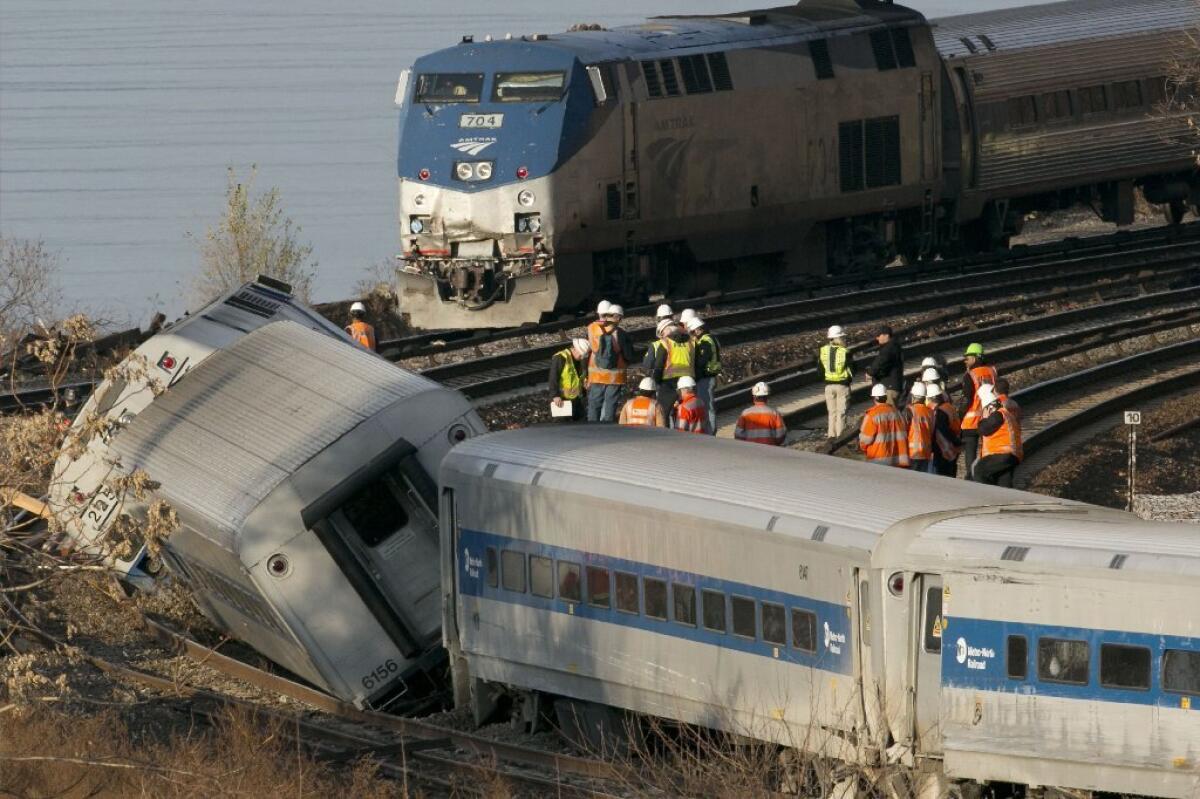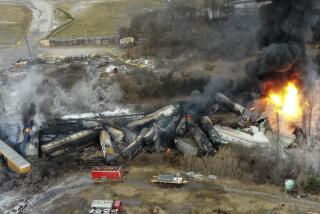Engineer in NYC train crash had ‘severe’ sleep apnea, report says

- Share via
NEW YORK -- The engineer of a train that derailed after speeding into a tight curve, killing four passengers, suffered from a “severe” sleep disorder, investigators said Monday in a report after the train operator’s admission that he “zoned out” shortly before the wreck.
A report from the National Transportation Safety Board included a detailed account of engineer William Rockefeller’s medical reports, and the transcript of an interview investigators did with Rockefeller two days after the Dec. 1, 2013, crash of the Metro-North Railroad train.
The NTSB also released transcripts of interviews with Metro-North employees, including three who were on the train and who described the chaos as cars tumbled off the tracks before dawn on the Sunday after Thanksgiving.
The crash heightened calls for better safety standards on railways nationwide and particularly at Metro-North. The derailment was the fourth serious incident in seven months involving Metro-North, which serves New York City and its northern suburbs.
Among other things, the medical reports said that a post-crash sleep evaluation showed that Rockefeller experienced 52.5 to 67.5 episodes an hour while sleeping in which his airflow was disrupted for at least 10 seconds.
The norm is fewer than five such episodes an hour, the NTSB said. More than 30 events an hour is considered severe sleep apnea, it said.
In a statement after the latest NTSB documents were released, Democratic Sens. Charles E. Schumer of New York, and Richard Blumenthal of Connecticut, who have been critical of Metro-North’s safety record, said it was “almost surreal that someone with this ailment could be in charge of a train with hundreds of passengers on board. The tragic outcome should haunt Metro-North officials.”
The NTSB report also noted that at the time of the accident, Rockefeller had a mild upper respiratory infection and that toxicology tests showed he had a small amount of a sedating antihistamine in his system.
In his interview with investigators, Rockefeller described a routine work day, which began at 3:30 a.m. when he got out of bed to be on time for his scheduled 5:54 a.m. departure from Poughkeepsie.
Rockefeller told investigators he took a shower, began warming up his car for the 43-minute drive to Poughkeepsie and fed his cats. Once he reached Poughkeepsie, Rockefeller said, he got himself a cup of coffee and a roll and went over routine safety checks.
The train left on schedule and was due at New York’s Grand Central Terminal about 7:40 a.m.
It was a routine trip until about 7:20 a.m., as the train passed through Riverdale in the Bronx section of New York City.
“I was just looking straight ahead, and I don’t know how to describe it,” Rockefeller said, struggling to describe the “dazed” feeling he said he had.
“You know, looking straight ahead, almost like mesmerized. And I don’t know if anybody’s ever experienced like driving a long period of time in a car and staring at the taillights in front of them, and you get almost like that hypnotic feeling staring straight ahead,” he told investigators.
Rockefeller said he was jolted from his daze by the crash. He described being thrown around, then struggling to find a radio or phone to advise Metro-North of the emergency.
The derailment left the seven-car train sprawled across the tracks and strewn down a hill to the banks of the Harlem River. Investigators have determined that the train was traveling at 82 mph on a curve with a 30-mph speed limit when it went off the tracks.
One of the assistant conductors, Maria Herbert, said she was sitting in a car behind the engineer’s, taking a breather between collecting tickets, when she found herself tumbling across the floor.
“I think I hit the ceiling several times,” Herbert said. When the car stopped, Herbert was lying on the ground covered in seat cushions and other debris. The car was tipped on its side.
“People screaming. Glass, glass all over,” said Herbert, who was extricated from the pile of debris by another passenger but who was too badly injured to stand up. Rockefeller then appeared in the car and used her radio to call in the emergency, after learning that the radio in the engineer’s cab was not working.
Neither Herbert nor a second assistant conductor, Christopher Kelly, said they sensed anything unusual about the trip or felt the train was traveling faster than usual.
Another conductor, Michael Hermann, said he noticed something that “sounded a little bit odd” seconds before the crash, but it wasn’t enough to worry him. “It just -- it didn’t quite sound like it normally would, but I would say it was only about two seconds, and then the next thing I know my car bolted and I was gone,” Hermann said.
Twelve miles away in Grand Central Terminal, Metro-North employee Frank Lanzi was in the railroad’s control center. He told investigators that he saw train No. 8808 vanish from his screen and initially thought he might have put it onto the wrong track.
“And then as I was about to call him ... the conductor calls out, “Emergency. 8808, emergency, emergency emergency,” Lanzi told investigators.
“He says to me, ‘We were derailed. We’re all over the place,’” Lanzi said, recounting Rockefeller’s description of what had happened after he responded to the engineer’s emergency call.
Lanzi said he told Rockefeller he was dispatching help.
“And he says, we need as many medics as you can, as many ambulances, we have multiple injuries,” Lanzi said.
More to Read
Sign up for Essential California
The most important California stories and recommendations in your inbox every morning.
You may occasionally receive promotional content from the Los Angeles Times.














